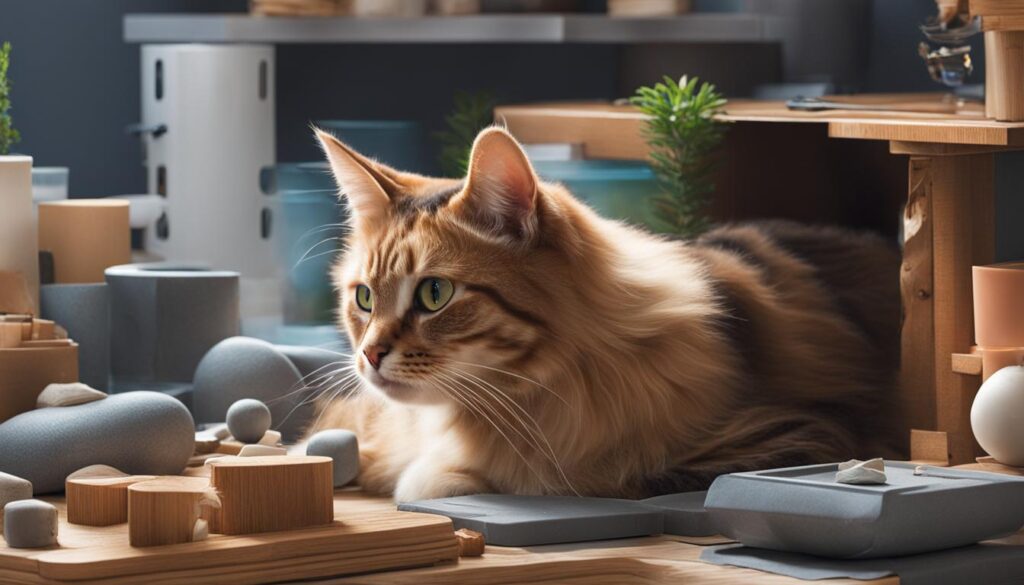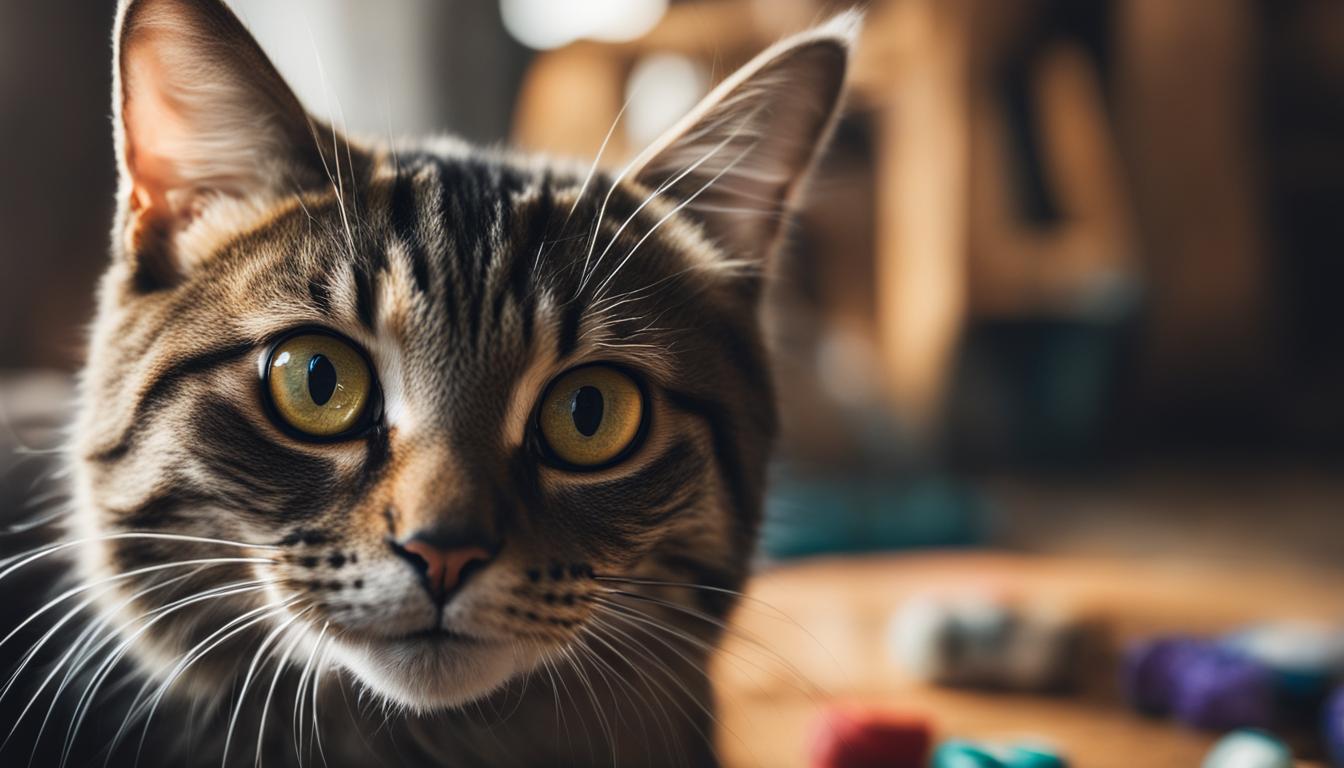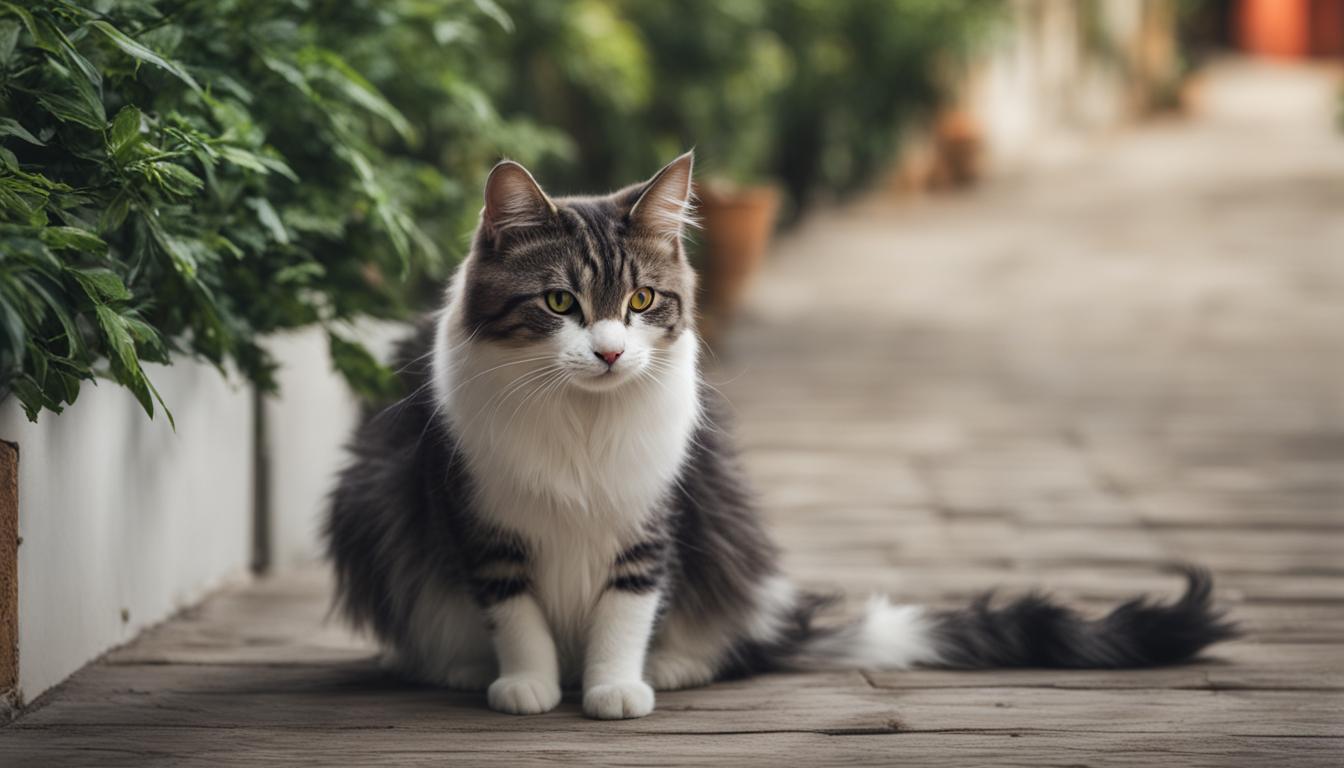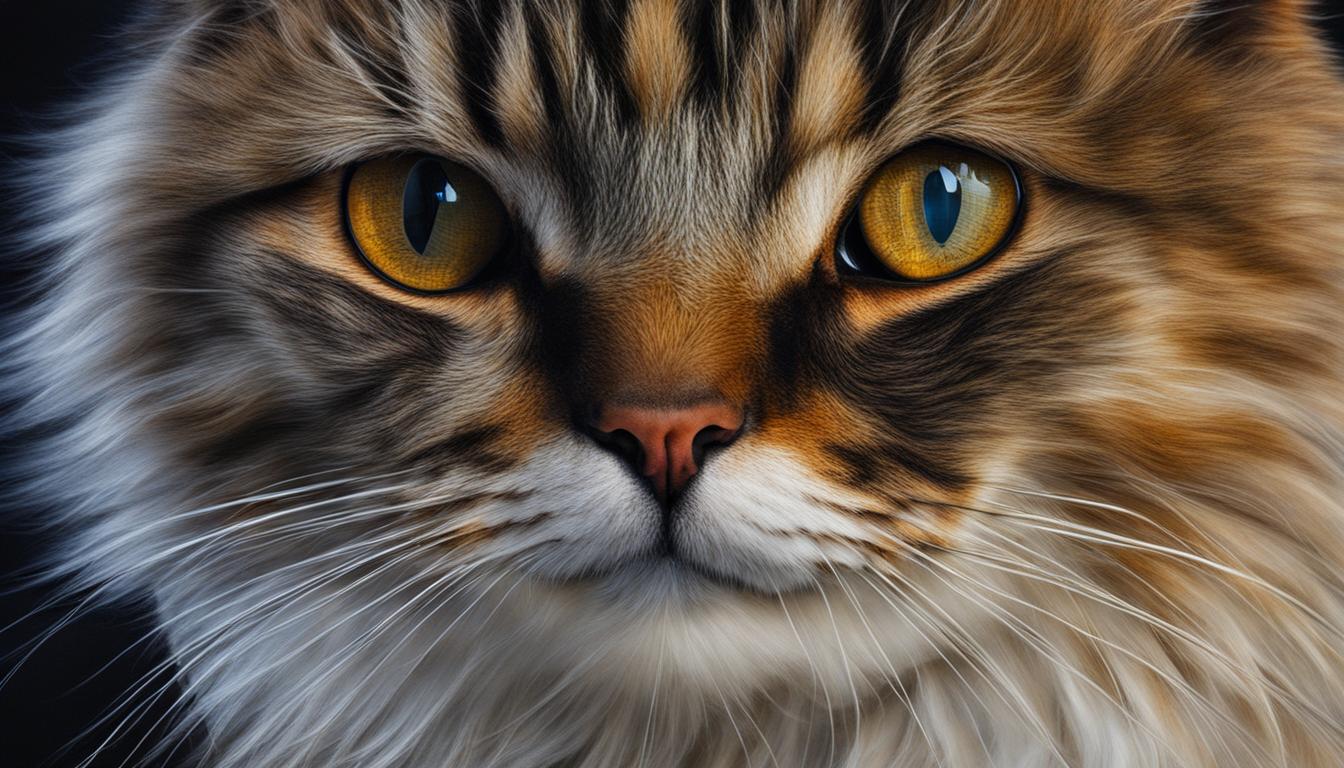Hey there, fellow feline enthusiasts! Today, let’s dive into the fascinating world of our four-legged companions and talk about something that affects them just as it affects us humans – stress and anxiety. Yes, that’s right, our beloved cats can experience these emotions too!
Cats are sensitive creatures, and changes in their environment or routine can trigger stress and anxiety. As responsible cat parents, it’s crucial for us to be able to recognize the signs of stress and anxiety in our furry friends. After all, a happy and stress-free cat is a healthier and more content companion!
Key Takeaways:
- Increased heart and respiratory rates, trembling, hiding, excessive vocalization, decreased appetite, and excessive grooming are common behavioral signs of stress and anxiety in cats.
- Environmental stressors such as changes in routine, new pets or family members, and loud noises can trigger stress in cats.
- Creating a safe and calm environment, using pheromone products, providing mental and physical stimulation, and establishing a routine can help manage cat anxiety naturally.
- Comforting a stressed cat during fear responses and avoiding punishment for fearful behavior is important to alleviate anxiety.
- Environmental management, behavioral modification, and potential medication may be necessary to treat stress and anxiety in cats. Consulting with a veterinarian is crucial for a personalized treatment plan.
Causes of Stress and Anxiety in Cats
Understanding the causes of stress and anxiety in cats is essential for cat owners looking to provide the best care for their furry friends. Environmental stressors play a significant role in triggering these emotions in cats. Changes in routine, such as moving to a new home or introducing a new pet or family member, can disrupt a cat’s sense of security and lead to stress and anxiety. Additionally, loud noises like fireworks or thunderstorms can be overwhelming for cats and create a fearful environment.
Cats are highly sensitive creatures, and even small changes in their surroundings can affect their emotional well-being. It’s important for owners to create a safe and calm environment for their cats to reduce stress levels. Providing hiding spots, elevated surfaces, and cozy beds can help cats feel secure. Consistency is also key – sticking to a regular feeding schedule and maintaining a predictable routine can help alleviate anxiety.
In addition to environmental factors, underlying medical conditions or physical pain can contribute to stress and anxiety in cats. It’s crucial for cat owners to partner with their veterinarian to rule out any health issues that may be causing or exacerbating these emotions. By addressing any underlying medical problems, owners can significantly improve their cat’s well-being and reduce stress levels.
Managing Cat Anxiety Naturally
While there are various medications available to treat stress and anxiety in cats, many owners prefer to explore natural management techniques first. These techniques focus on creating a calming environment and providing mental and physical stimulation for cats.
One effective method is the use of pheromone products, such as Feliway, which mimic the natural pheromones produced by cats to promote a sense of security and well-being. These products can be used in the form of diffusers, sprays, or collars, and can help reduce stress levels in cats.
Engaging cats in play and providing environmental enrichment can also be beneficial in managing anxiety. Interactive toys and puzzle feeders can keep cats mentally stimulated, while scratching posts and climbing trees offer physical outlets for them to release tension. Additionally, creating vertical spaces, such as wall shelves or cat trees, allows cats to observe their surroundings from a safe vantage point and feel more in control.
In conclusion, stress and anxiety in cats can stem from various factors, including environmental stressors and underlying medical conditions. By creating a calm and secure environment, addressing any potential health issues, and incorporating natural management techniques, owners can help alleviate stress and anxiety in their feline companions, providing them with a happier and healthier life.
| Causes of Stress and Anxiety in Cats | Managing Cat Anxiety Naturally |
|---|---|
| Change in routine | Pheromone products |
| New pets or family members | Play and environmental enrichment |
| Loud noises (fireworks, thunderstorms) | Creating vertical spaces |
| Underlying medical conditions |

How to Help a Stressed or Anxious Cat
When it comes to helping a stressed or anxious cat, there are several steps that cat owners can take to provide comfort and support. It’s important to remember that each cat is unique, and what works for one may not work for another. However, there are some general strategies that can help in reducing cat anxiety.
Recognizing Hidden Stress in Cats
Cats are masters at hiding their stress, and it’s important for cat owners to be observant and look for subtle signs. Some cats may exhibit signs of stress through changes in their litter box habits, such as urinating outside the box or avoiding the litter box altogether. Other cats may engage in excessive grooming or exhibit aggressive behavior towards other pets or family members. By understanding the hidden signs of stress in cats, cat owners can intervene early and provide the necessary support.
Reducing Cat Anxiety with Pheromones
Pheromone products, such as Feliway, can be effective in reducing cat anxiety and creating a more calming environment. These synthetic pheromones mimic the natural facial pheromones that cats release when they feel safe and secure. By spraying or diffusing pheromones in areas where the cat spends most of its time, cat owners can help create a sense of security and comfort for their feline companion. Pheromone products can be particularly useful in situations such as introducing a new pet or family member, moving to a new home, or during fireworks or thunderstorms.
“Using pheromone products can help reduce cat anxiety and create a more calming environment for the cat.”
Providing a Safe and Calm Environment
Creating a safe and calm environment is crucial in helping a stressed or anxious cat. Cat owners should provide hiding spots or safe spaces where the cat can retreat when feeling overwhelmed. These spaces can include cozy beds, cat trees, or even cardboard boxes with soft blankets. It’s important to allow the cat to have alone time and not force interaction when they are feeling anxious. By providing a calm environment, cat owners can help their feline friends feel more secure and reduce their anxiety levels.

By following these strategies, cat owners can play a crucial role in helping their stressed or anxious cats. It’s important to remember that patience and understanding are key, as it may take time for cats to adjust and feel more at ease. If a cat’s anxiety persists or worsens despite these efforts, it’s recommended to consult with a veterinarian for further guidance and support.
Treating Stress and Anxiety in Cats
Cats, like humans, can experience stress and anxiety. It’s important for cat owners to recognize the behavioral signs of cat depression and stress-induced behaviors in cats so that they can provide appropriate treatment and support. By addressing these issues, cat owners can help their feline companions live happier and healthier lives.
Behavioral Signs of Cat Depression
Cat depression can manifest in various ways. Some common behavioral signs include decreased interest in food or play, excessive sleep, social withdrawal, and changes in grooming habits. Cats may also show signs of irritability, aggression, or increased vocalization. It’s crucial to pay attention to these changes in behavior and seek professional advice if needed.
Table: Behavioral Signs of Cat Depression
| Behavioral Signs | Description |
|---|---|
| Decreased appetite | Cat shows little or no interest in food |
| Reduced activity | Cat becomes lethargic and shows decreased interest in play |
| Social withdrawal | Cat isolates itself and avoids interaction with humans or other pets |
| Changes in grooming habits | Cat may groom excessively or neglect grooming altogether |
| Irritability or aggression | Cat displays aggressive behaviors or becomes easily irritated |
| Increased vocalization | Cat vocalizes more frequently or excessively |
Stress-Induced Behaviors in Cats
Stress can also lead to various behaviors in cats. These behaviors may include excessive grooming, urine marking, hiding, aggression, and destructive chewing or scratching. Cats’ response to stress can vary, and it’s important to identify the specific triggers for individual cats to effectively manage their anxiety.
Table: Stress-Induced Behaviors in Cats
| Stress-Induced Behaviors | Description |
|---|---|
| Excessive grooming | Cat spends an excessive amount of time grooming, leading to hair loss or skin irritation |
| Urine marking | Cat marks their territory by urinating outside the litter box |
| Hiding | Cat seeks out secluded areas and avoids interaction |
| Aggression | Cat displays aggressive behaviors towards humans or other animals |
| Destructive chewing or scratching | Cat damages furniture, objects, or themselves through excessive chewing or scratching |
It’s important to note that each cat is unique, and their response to stress and anxiety may differ. Consulting with a veterinarian or a professional animal behaviorist can help determine the underlying causes of stress in cats and develop a personalized treatment plan. Treatment options may include environmental modifications, behavioral training, pheromone therapy, or, in severe cases, medication. With the right approach and support, cats can overcome stress and anxiety and enjoy a better quality of life.
Conclusion
As a cat owner, I understand the importance of recognizing the signs of stress and anxiety in our feline friends. By being aware of these signs and taking proactive steps, we can help our cats manage their anxiety naturally and create a peaceful environment for them.
Stress and anxiety can manifest in various ways, including increased heart and respiratory rates, trembling, hiding, excessive vocalization, decreased appetite, and excessive grooming. These signs may range from mild to severe, and it’s crucial to address them as soon as we notice them to prevent further distress.
Managing Cat Anxiety Naturally
One of the key strategies for managing cat anxiety naturally is providing a safe and calm environment. This includes minimizing exposure to stressors, establishing a routine, and creating designated spaces where our cats can retreat and feel secure.
In addition, mental and physical stimulation through play and enrichment activities can help alleviate anxiety in cats. Interactive toys, scratching posts, and puzzle feeders are great options to keep our cats mentally engaged and physically active.
Recognizing Cat Anxiety Symptoms
Recognizing cat anxiety symptoms is essential for early intervention. By identifying the underlying causes of stress in our cats, such as health issues or changes in their environment, we can better address their anxiety. Regular veterinary check-ups can help identify any health concerns that may be contributing to our cat’s anxiety.
Finally, it’s important to remember that each cat is unique, and what works for one may not work for another. If we suspect that our cat is exhibiting signs of stress or anxiety, it’s recommended to consult with our veterinarian. They can provide a comprehensive evaluation and create a personalized treatment plan tailored to our cat’s specific needs.
FAQ
What are the signs of stress and anxiety in cats?
Signs of stress and anxiety in cats can include increased heart and respiratory rates, trembling, hiding, excessive vocalization, decreased appetite, and excessive grooming.
What can cause stress and anxiety in cats?
Environmental stressors such as changes in routine, new pets or family members, and loud noises can trigger stress in cats. Underlying medical conditions or physical pain can also contribute to anxiety in cats.
How can I help calm my stressed or anxious cat?
Comforting the cat during moderate to severe fear responses can help soothe the cat. Avoid punishing the cat for fearful behavior, as this can worsen the anxiety. Providing a safe and calm environment, using pheromone products, and establishing a routine for your cat can also help.
What are some natural ways to manage cat anxiety?
You can manage your cat’s anxiety naturally by providing a safe and calm environment, using pheromone products, providing mental and physical stimulation through play and enrichment activities, and establishing a routine for your cat.
How can I treat stress and anxiety in my cat?
Treatment for stress and anxiety in cats usually involves a combination of environmental management, behavioral modification, and potential medication. It’s important to work closely with your veterinarian to develop a personalized treatment plan based on the specific needs of your cat.





